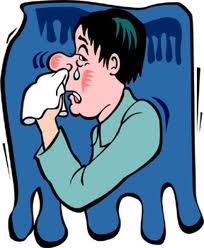 CHIROPRACTIC FOR HAY FEVER Presented by Dr. Masoud Shamaeizadeh Hay fever is an acute inflammation or excessive heat of the mucous membranes lining the nasal passages, as a general rule, and in some cases the inflammation extends down as far as the bronchi. This in coordination is characterized by a thin, watery discharge from the nose. The upper portions of the respiratory tract are so swollen from the inflammation existing that breathing is very difficult, especially through the nasal passages, and the patient often resorts to mouth breathing. The discharge from the nose is of a thin, watery, acrid character, and is almost continuous in its exudation from the mucous membranes lining the air passages of the nose. The mucous membrane of the nose, owing to the acute inflammation and congestion, is very sensitive, and as a result of this sensitiveness the patient sneezes very frequently. Hay fever, in its most pronounced form, generally makes its appearance in the late summer, generally the latter part of July or early August, and with most sufferers terminates about the first part of October. It is commonly supposed to be caused by some flower or weed or effluvia from some plant, weed or flower. This commonly supposed “cause” varies from the so-called “rag-weed” in certain sections to the effluvia from the “rose” in other sections, or the dust from freshly cut hay or weeds in other sections, this supposed cause depending on the character of the neighborhood and the flora of that neighborhood in which the patient resides. The pronounced stage of this dis-ease begins with sneezing, the same as with an ordinary cold; the eyes become easily irritated, tears flow easily and continuously; the eyeballs become inflamed and the tissues around the eyeballs and the eyelids become congested and reddened. There is an almost continuous watery discharge from the nose. Because of the irritation produced by the extreme sensitivity of the mucous membranes lining the nasal passages and the consequent sneezing and difficult breathing, sleep is very difficult and the patient is very restless and irritable during the sleeping hours. Because of the congested condition of the mucous membrane of the nasal passages, the sense of smell is greatly impaired, often to such an extent that there is no sense of smell present, and the patient is unable to detect the most pronounced of odors. The sense of sight is also impaired because of the irritation of the eyes and their surrounding tissues. Because of the continued sneezing in this in coordination. inflammation may extend down into the trachea, bronchi, and eustachian tubes. impairing the sense of hearing. Temporary deafness may result, wherein the patient is unable to hear even the loudest of noises. Medically, this in coordination is considered incurable, and the only relief some doctors can promise the sufferer from this dis-ease is to send the patient to a higher altitude or to a drier climate, or to a climate where the supposed “cause”, the effluvia from the particular plant. weed or vegetation that is the particular pet bane of the patient is not present. In the eastern states the remedy prescribed is usually to go to Maine or up in the mountains, while in the middle western states. it is to go to Colorado or Michigan or Wisconsin. The great majority of these sufferers, however, cannot afford the time from their business or the money to take a vacation or several months for the purpose of ridding themselves of the supposed “cause” of this dis-ease, and they remain at their homes and places of business throughout the season, often suffering untold discomfort from the dis-ease. Chiropractically, the cause of this in coordination is a vertebral subluxation. The nerves going to the affected portions of the upper air passages of the respiratory tract emit from the spine, and when an impingement of these nerves occurs, it is necessary to release such interference by chiropractic care for the purpose of restoring normal transmission of nerve force between the brain and the affected organs of the body. As stated before, medically this in coordination is considered practically incurable and the medical treatment is given merely with a view of removing the irritation or of allaying the most imitating symptoms of the dis-ease. But, from a chiropractic standpoint, the prognosis is very favorable, and recovery is nearly always the rule. The chiropractor seeks to so adjust the subluxated vertebra that all interference is removed from the spinal nerves, thus permitting the free and uninterrupted flow of the mental impulse current from the brain to the mucous membranes lining the upper air passages of the respiratory tract and, where other portions of the mucous membrane of the respiratory tract are involved, to these parts, resulting in normal expression and normal functioning. If the dis-ease is of long standing, then it may be a matter of some months before the mental impulse current may flow unobstructed and unhindered to the mucous membranes lining the nasal passages. In this class of cases, where the patient has had this dis-ease through several seasons running over a course of several years, the patient should begin chiropractic care some weeks or months before the usual time for the appearance of the marked symptoms of this in coordination, so as to have the subluxation adjusted to its normal position, the impingement from the nerves removed, and unhindered flow of mental impulse current to the parts affected existing, so as to have the tissue in proper condition of coordination to resist the irritants bringing on the acute state of the dis-ease.
0 Comments
Leave a Reply. |
New Patient SpecialArchives
July 2024
Categories |



 RSS Feed
RSS Feed
